EMD Artists (Redux) |
|
|---|---|
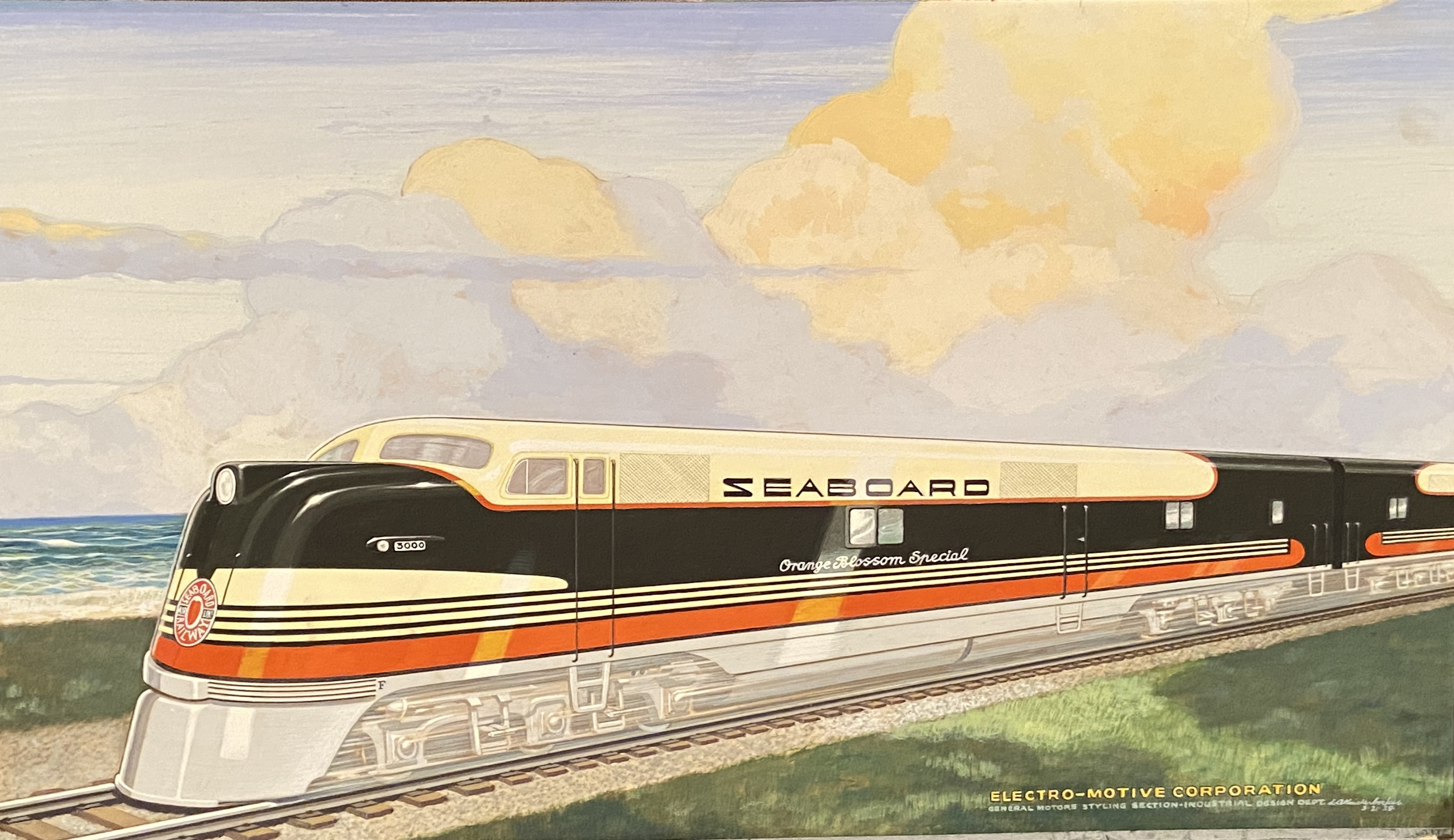 Artist Leland Knickerbocker envisioned Seaboard Air Line's early E-units rolling along the shore lines of the sunny south. (Greg Palumbo collection. |
|
|
Railroading lost no time after World WarII in shedding military fatigues and redirecting its
energies towards winning new business. North American railroads were investing heavily in new
trains, equipment and diesel locomotives and the Electro-Motive Division of General Motors
was fully intent on capitalizing. The Illinois-based manufacturer was clearly the preeminent
builder of diesel locomotives at the time, and the company wanted the rail industry and traveling
public to beware of that fact. To that end, locomotive artwork was an important component
of EMD's overall marketing approach. The builder used in-house art staff as well agency graphic
artists / illustrators to create colorful and dynamic artwork that helped generate sales.
The artwork was used extensively on posters, product catalogs, pocket calendars, and builder
data/spec cards, as well as for trade publication covers.
It should be noted that prior to the global conflict the brush strokes and pen work of Leland Knickerbocker (1937-1940) and Paul A. Meyer set the foundation for the future streamlined stylings of EMD artwork and graphics. Both of the designers / illustrators were on the staff of EMD parent General Motors before shifting focus from automobiles to locomotives. During the post World War II years, the most notable names among the group of graphic designers were EMD's own Ben Dedek and Harry Bockewitz, as well as agency designers Bern Hill and Tom Fawell. Each of the graphic specialists possessed a unique style that was visibly evident in their work. Moreover, their artistry often reflected social and economic activity of the specific time period, and all the while depicting the advantages of diesel versus steam-driven power. Ben Dedek - (1941 to mid 1950s). The diesel locomotive was still in its infancy, especially in terms of hauling freight, and EMD needed artwork that touted its dominant role. That task often fell to the talented Ben Dedek who was a strong product illustrator. His artwork helped turn the bulldog-nose of the EMD-built passenger and freight cab into a national icon. He used strong colors and detail to hold the viewers attention, while water-colored backgrounds faded into the distance. Additionally, his imagery helped potential EMD customers envision the character of a future locomotive purchase. It's not surprising that his series of 108 builder / specification cards remain collector items. Harry Bockewitz - (1941-1961).Unfortunately, very little information regarding Bockewitz was readily available. His time at EMD seems to overlap the period of Bern Hill and Ben Dedek. He mostly worked with strong tempera watercolors, however the skies in his paintings often appeared soft and washed-out. Over the years, his artwork has grown in value among collectors. Bern Hill - (1950s). By the end of 1949, EMD was clearly the dominant force among all locomotive builders, which allowed for a more philosophical approach to advertising art. Enter Bern Hill, an artist on the staff the Kudner Advertising Agency. "Aesthetically innovative and historically important" are words knowledgeable critics have used to describe Hill's railroad illustrations. The talented Hill created panoramic and birds-eye views that placed the viewer at a distance; his style was at the junction of realism and abstract. Hill's paintings sometimes adorned the cover of Railway Age magazine (1950 to 1956). Additionally, Trains requested and received permission from EMD to use a few of Hill's locomotive artwork on the magazine's cover in the early 1970s.
Tom Fawell - (Early 1960s-1970). The railroad artistry of Tom Fawell is worth far
more than a thousand words. Using vibrant color and a dark mood, he crafted dynamic scenes that
captured the speed, power and drama of EMD-built locomotives at work. Fawell once described
his initial meeting with EMD managers, Nick Zullo. With its brand well established as EMD entered the 1970s, the LaGrange builder placed responsibility for locomotive artwork and graphics in the very capable hands of young staff artist Nick Zullo. John Jordal. Graphic illustrations were shifted to EMD artist John Jordal, during the 1990s, augmented with the use of outside design sources.
The artistry and inspiration of EMD's design staff changed the face of the railroad industry
and helped establish a strong corporate identity / image that endured for many decades.
blank Text & Format: R. Craig Rutherford Additional images and artists background data provided by Greg Palumbo |
|
Early ATSF E-unit
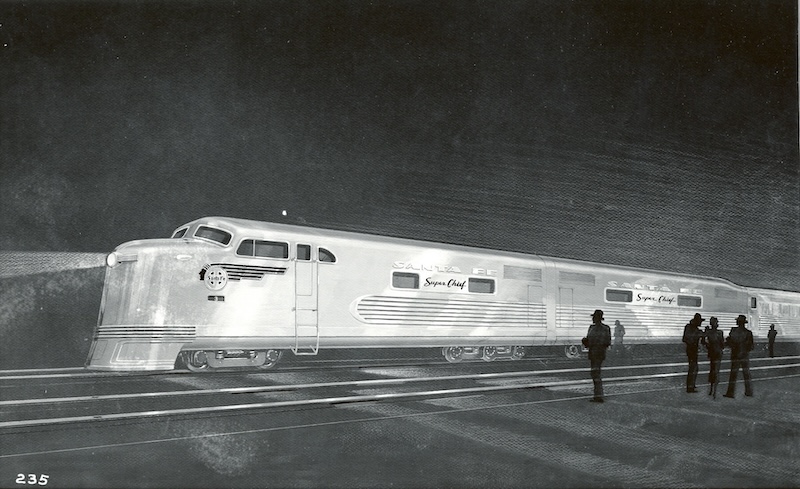 Prior to Atchison Topeka & Santa Fe's introduction of its new classy "Super Chief" service they sought a streamlined diesel on the point. Several concepts were explored prior to Leland Knickerbocker's design of the above E-unit. The slant nose and iconic "War Bonnet" attire were dynamic refinements later added by the artist. (Greg Palumbo collection) |
Rock Island Rockets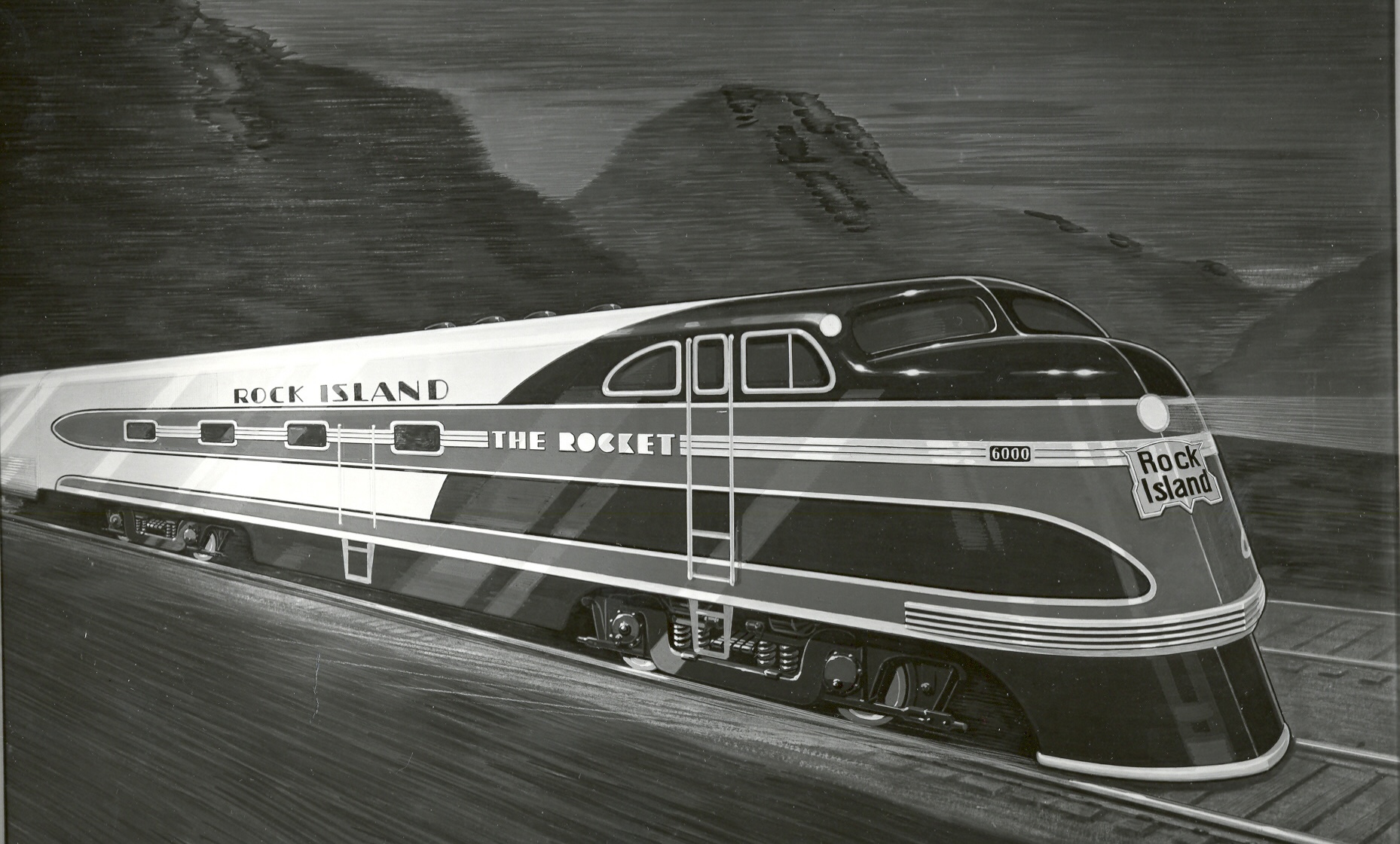 Here is another crisp Leland Knickerbocker illustration; he created this one while still at the General Motors Styling Section in Detroit, Michigan. Developed for the Chicago Rock Island & Pacific, the proposed E-unit's slanted nose conveys a sense of modern styling and speed. (Greg Palumbo collection) |
UP / C&NW Passenger E-Unit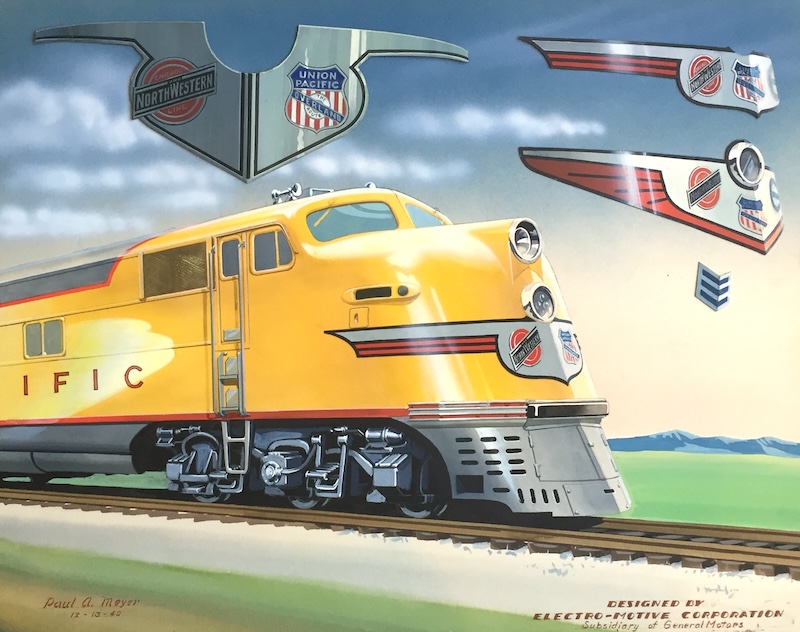 Paul Meyer's locomotive artwork was detail oriented right down to last door latch. Conversely, his foregrounds and backgrounds were low-key so as not to pull attention from the main subject. (Greg Palumbo collection) |
M&StL FTs w/ Freight
 Too few color photographs exist of the Minneapolis & St. Louis railroad's small fleet of FTAs (four A-Units) & FTSBs (two B-units) built during the final year of WWII. This Harry Bockewitz artwork of FTA/B/A #445 rolling across agricultural farmland in the midwest is a worthwhile substitute and reminder. (Streamliner Memories Website) |
ATSF FTs w/ Freight
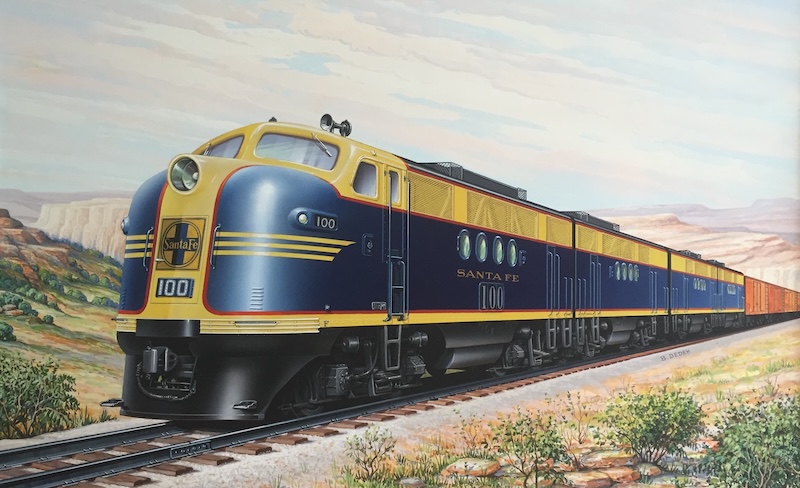 Atchison Topeka & Santa Fe's popular freight attire from the 1940s was its best when applied to the bulldog nose of EMD-cab units. Artist Ben Dedek showcases the railroad's first diesel-powered freight cab set in classic A/B/B/A configuration rolling across the grasslands of eastern Texas with ATSF FT #100 on the point. (Greg Palumbo collection) |
EMD F3 Demos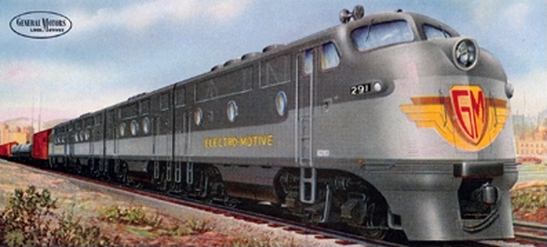 When WWII hostilities ended many mainline and a few short line railroads contemplated the replacement of aging steam power with more new versatile and flexible diesel-driven road locomotives. Ben Dedek portrayed an A/B/B/A set of F3 "sales ambassadors" ready to visit many railroads and showcase their 6000-hp in hopes of expediting a decision to purchase new freight cab units. The highly successful EMD promotion campaign generated a large locomotive backlog for the LaGrange builder. (Ralph Back collection) |
BAR BL2 w/ Freight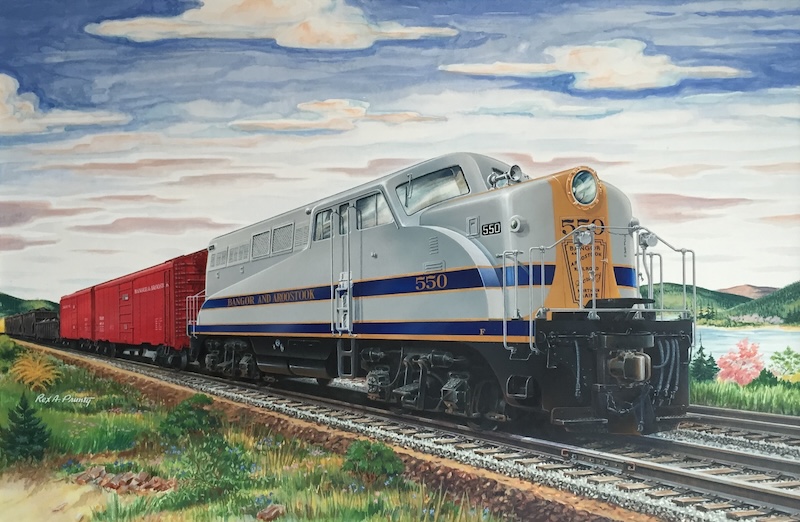 A rare Bangor & Aroostook BL2 is portrayed in this Rex Prunty illustration. A member of the EMD Styling Group, his work bears a strong resemblance to that of Ben Dedek; the biggest difference perhaps is that his name gets little recognition. (Greg Palumbo collection) |
B&Os "Capitol Limited"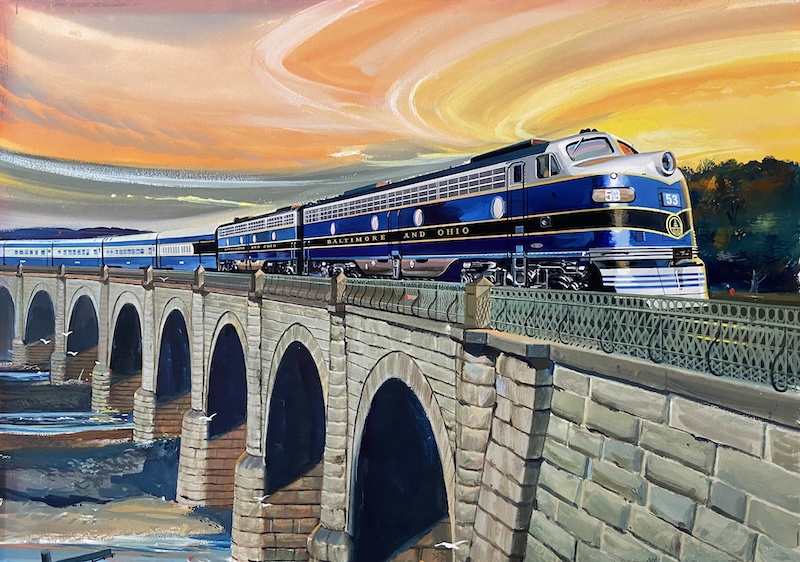 Kudner Advertising Agency was retained occasionally by EMD to handle overflow assignments and projects requiring a quick turn-around, such as this painting by the Agency's Rick Handville of E8As leading the "Cap" out of Washington D.C. (Greg Palumbo collection) |
ERIE F3 SPEC CARD
General Motors Electro Motive Division, La Grange Illinois, produced 7.5 The back of the spec card tells you everything you would want to know about the pictured unit. (Ralph Back collection & text) |
 |
Railway Age Cover Art General Motors, the consumate marketer, often purchased the cover space of Railway Age magazine to announce recent new locomotive buyers, such as the Atlanta & West Point. (Detroit Public Library Archive) |
GN F3s w/ Streamliner Bern Hill's canvas possibly portrays Great Northern's "Empire Builder" rolling gracefully through Marshall Canyon in Eastern Washington state (Detroit Public Library Archive) |
DRGW F7s w/ "Royal Gorge" A trio of four-axle Denver & Rio Grande Western F7s roll through Colorado's Royal Gorge in this Bern Hill depiction from the early 1970s. (Detroit Public Library Archive) |
WP F3s w/ "Silver Lady" Here is another of Bern Hill's drawings that appeared on the cover of Trains Magazine. This one depicts the California Zephyr snaking through the Rocky Mountains. (Trains Magazine Archive) |
C&O GP30s w/Freight Chesapeake & Ohio's 48 new EMD GP30s arrived during 1962/63. Tom Fawell's rendering places several of the newcomers in an industrial setting to reflect the model's multiple uses. (Trains Magazine Archives) |
SOO GP30 w/Freight SOO Line purchased 22 EMD-built GP30s in 1962; they sported the company's new look. Tom Fawell artistically shows three of them high above the St. Croix River. (Deane Motis collection) |
DRGW GP30s w/Freight When it comes to Tom Fawell's artwork there seems to be no middle ground. For example, within EMD there were two camps -- Those that like it, and those that did not. (Ralph Back collection) |
NP SD45s w/ Freight The artistry of Tom Fawell has a trio of Northern Pacific SD45s with a high-priority freight conquering the Rocky mountains. (Ralph Back collection) |
Amtrak Electric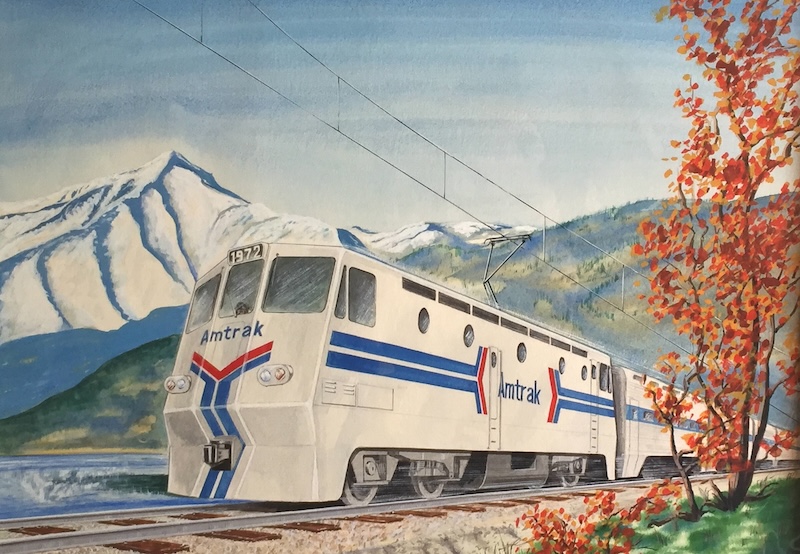 Nick Zullo another talented EMD artist depicts a proposed electric motor running along Amtrak's heavily trafficed "Northeast Corridor."" The quasi-public agency has devoted considerable time and money over the years to find the ideal replacement locomotive. (Greg Palumbo collection) |
UP Motive Power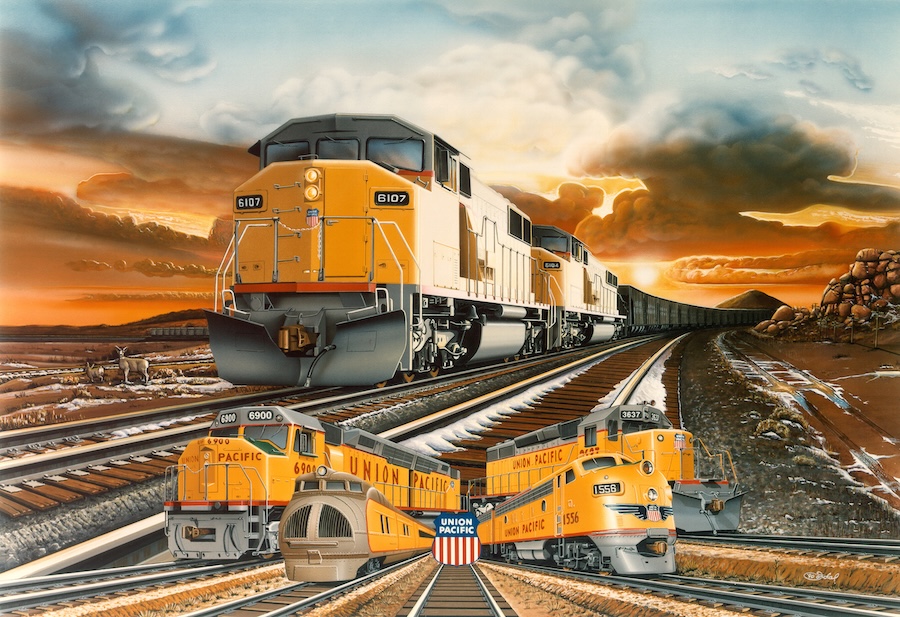 EMD's staff Artist John Jordal created this dynamic montage of Union Pacific power. The original artwork, which shows a SD60 team conquering Sherman Hill in Wyoming and a small cluster of early and late mode EMDs position below, was presented to Union Pacific management. (Greg Palumbo collection) |
Acknowledgements |
|
| Redux Upload: 1 April 2025 | |